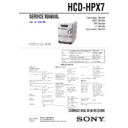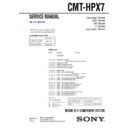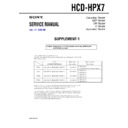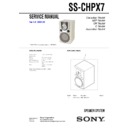Sony CMT-HPX7 / HCD-HPX7 Service Manual ▷ View online
SERVICE MANUAL
Sony Corporation
Personal Audio Division
Published by Sony Techno Create Corporation
Published by Sony Techno Create Corporation
Canadian Model
AEP Model
UK Model
E Model
Australian Model
COMPACT DISC DECK RECEIVER
9-877-911-09
2006I16-1
© 2006.09
© 2006.09
Ver. 1.8 2006.09
SPECIFICATIONS
HCD-HPX7
HCD-HPX7 is the amplifier, CD player,
tape deck and tuner section in CMT-HPX7.
tape deck and tuner section in CMT-HPX7.
SPEAKER:
o
Accepts impedance of 6 t
16 ohms.
16 ohms.
CD player section
Laser
Semiconductor laser
(
(
λ=780 nm)
Emission duration:
continuous
continuous
Frequency response
20 Hz – 20 kHz
Tape deck section
Recording system
4-track 2-channel, stereo
Frequency response
50 – 13,000 Hz (
±3 dB),
using Sony TYPE I
cassettes
cassettes
Tuner section
FM stereo, FM/AM superheterodyne tuner
FM tuner section
Tuning range
87.5 – 108.0 MHz
Antenna
FM lead antenna
Antenna terminals
75 ohms unbalanced
Intermediate frequency
10.7 MHz
AM tuner section
Tuning range
Pan-American model:
Pan-American model:
530 – 1,710 kHz
(with the tuning interval
set at 10 kHz)
531 – 1,710 kHz
(with the tuning interval
set at 9 kHz)
(with the tuning interval
set at 10 kHz)
531 – 1,710 kHz
(with the tuning interval
set at 9 kHz)
European model:
531 – 1,602 kHz
(with the tuning interval
set at 9 kHz)
(with the tuning interval
set at 9 kHz)
Other models:
530 – 1,710 kHz
(with the tuning interval
set at 10 kHz)
531 – 1,602 kHz
(with the tuning interval
set at 9 kHz)
set at 10 kHz)
531 – 1,602 kHz
(with the tuning interval
set at 9 kHz)
Antenna
AM loop antenna, external
antenna terminal
antenna terminal
Intermediate frequency
450 kHz
General
Power requirements
North American model: 120 V AC, 60 Hz
North American model: 120 V AC, 60 Hz
120 V AC, 60 Hz
220 V AC, 60 Hz
120 V AC, 50/6
0 0 Hz
Australian model:
230 – 240 V AC, 50/60 Hz
European model:
230 V AC, 50/60 Hz
Taiwan model:
Korean model:
Mexican model:
Korean model:
Mexican model:
Other models:
120 V, 220 V or 230 – 240
V AC, 50/60 Hz
Adjustable with voltage
selector
V AC, 50/60 Hz
Adjustable with voltage
selector
Power consumption
European model:
European model:
115 W
Other models:
90 W
Design and specifications are subject to change
without notice.
without notice.
Main unit
Amplifier section
European model:
DIN power output (rated): 50 + 50 W
DIN power output (rated): 50 + 50 W
Continuous RMS power output (reference):
60 + 60 W
(6 ohms at 1 kHz, DIN)
(6 ohms at 1 kHz, 10%
THD)
THD)
Music power output (reference): 100 + 100 W
Other models:
The following measured at AC 240 V, AC 220 V or AC
120 V
DIN power output (rated): 45 + 45 W
Other models:
The following measured at AC 240 V, AC 220 V or AC
120 V
DIN power output (rated): 45 + 45 W
(6 ohms at 1 kHz, DIN)
Continuous RMS power output (reference):
50 + 50 W
Outputs
PHONES:
PHONES:
Accepts headphones with
an impedance of 8 ohms or
more.
an impedance of 8 ohms or
more.
Inputs
MD/VIDEO:
MD/VIDEO:
Sensitivity 450/250 mV,
impedance 47 kilohms
impedance 47 kilohms
(6 ohms at 1 kHz, 10%
THD)
THD)
Model Name Using Similar Mechanism
HCD-HPX9
CD
CD Mechanism Type
CDM82A-F1BD81
Section
Base Unit Name
BU-F1BD81A
Optical Pick-up Block Name
KSM-215DCP
Tape deck
Model Name Using Similar Mechanism
HCD-HPX9
Section
Tape Transport Mechanism Type
CMAL5Z225A
2
HCD-HPX7
TABLE OF CONTENTS
1.
SERVICING NOTES
................................................
4
2.
GENERAL
...................................................................
5
3.
DISASSEMBLY
3-1.
Disassembly Flow-1 ........................................................
7
3-2.
Disassembly Flow-2 ........................................................
8
3-3.
Optical Pick-Up Block ....................................................
9
3-4.
Side Plate (L) (R), Top Panel Section .............................. 10
3-5.
Mechanical Deck ............................................................. 11
3-6.
Front Panel Section ......................................................... 12
3-7.
PANEL (1), (2) Board, HEADPHONE Board ................ 12
3-8.
Tuner (FM/AM), DC Fan ................................................ 13
3-9.
MAIN Board .................................................................... 14
3-10. Rear Panel Section ........................................................... 14
3-11. AMP Board, Switching Regulator ................................... 15
3-12. POWER Board ................................................................ 15
3-13. CD Mechanism Deck (CDM82A) ................................... 16
3-14. Plate (Cover Top) ............................................................. 17
3-15. Top Section ...................................................................... 17
3-16. Arm Section ..................................................................... 18
3-17. CD Mechanism Deck Section ......................................... 19
3-18. Sub Gear (2 Step), Sub Slider Assy ................................. 20
3-19. Arm (R) ........................................................................... 21
3-20. Gear (Stock Planet) (Right) ............................................. 22
3-21. Lever (Sub Gear Back L) ................................................ 22
3-22. Arm (L) ............................................................................ 23
3-23. Gear (Stock Rot Long) (Left) .......................................... 24
3-24. Gear (Stock Rot Short) (Right) ....................................... 24
3-25. Stocker (1) Assy To Stocker (5) Assy .............................. 25
3-26. SPR-E (Roller Slider Upper) (Top Section) .................... 26
3-27. Rubber Roller (Top Section) ........................................... 26
3-28. LOD Motor ...................................................................... 27
3-29. Slider (Push-popup) ......................................................... 27
3-30. Rotary Encoder ................................................................ 28
3-31. Assembling of the Rotary Encoder ................................. 29
3-32. ELV Motor ....................................................................... 30
3-33. Chassis (Top), Chassis (Bottom) ..................................... 31
3-34. Lever (Loading R, Loading L) ........................................ 32
3-35. Disc Stop Lever ............................................................... 33
3-36. DRIVER Board ............................................................... 33
3-37. CD Board ......................................................................... 34
3-38. Optical Pick-up (KSM-215DCP) .................................... 34
3-39. Base Unit Section ............................................................ 35
3-40. Lever (BU Lock) ............................................................. 35
3-41. Gear (IDL-B) ................................................................... 36
3-42. Gear (IDL-C) ................................................................... 36
3-43. SPR-E (Tako-Back) ......................................................... 37
3-44. Plate (Push) Assy ............................................................. 38
3-45. SPR-P (Lock) .................................................................. 39
3-11. AMP Board, Switching Regulator ................................... 15
3-12. POWER Board ................................................................ 15
3-13. CD Mechanism Deck (CDM82A) ................................... 16
3-14. Plate (Cover Top) ............................................................. 17
3-15. Top Section ...................................................................... 17
3-16. Arm Section ..................................................................... 18
3-17. CD Mechanism Deck Section ......................................... 19
3-18. Sub Gear (2 Step), Sub Slider Assy ................................. 20
3-19. Arm (R) ........................................................................... 21
3-20. Gear (Stock Planet) (Right) ............................................. 22
3-21. Lever (Sub Gear Back L) ................................................ 22
3-22. Arm (L) ............................................................................ 23
3-23. Gear (Stock Rot Long) (Left) .......................................... 24
3-24. Gear (Stock Rot Short) (Right) ....................................... 24
3-25. Stocker (1) Assy To Stocker (5) Assy .............................. 25
3-26. SPR-E (Roller Slider Upper) (Top Section) .................... 26
3-27. Rubber Roller (Top Section) ........................................... 26
3-28. LOD Motor ...................................................................... 27
3-29. Slider (Push-popup) ......................................................... 27
3-30. Rotary Encoder ................................................................ 28
3-31. Assembling of the Rotary Encoder ................................. 29
3-32. ELV Motor ....................................................................... 30
3-33. Chassis (Top), Chassis (Bottom) ..................................... 31
3-34. Lever (Loading R, Loading L) ........................................ 32
3-35. Disc Stop Lever ............................................................... 33
3-36. DRIVER Board ............................................................... 33
3-37. CD Board ......................................................................... 34
3-38. Optical Pick-up (KSM-215DCP) .................................... 34
3-39. Base Unit Section ............................................................ 35
3-40. Lever (BU Lock) ............................................................. 35
3-41. Gear (IDL-B) ................................................................... 36
3-42. Gear (IDL-C) ................................................................... 36
3-43. SPR-E (Tako-Back) ......................................................... 37
3-44. Plate (Push) Assy ............................................................. 38
3-45. SPR-P (Lock) .................................................................. 39
4.
ASSEMBLY
4-1.
Assembly Flow ................................................................ 40
4-2.
Assembling of the Stocker Section ................................. 41
4-3.
Assembling of the Gear (Stock Rot Short) (Right) ......... 42
4-4.
Assembling of the Gear (Stock Rot Long) (Left) ............ 43
4-5.
Confirming the Assembling of the Stocker Section ........ 44
4-6.
Assembling of the Gear (Stock Rotary Left) ................... 45
4-7.
Assembling of the Gear (Stock Rotary Right) ................ 46
4-8.
Assembling of the Lever (Sub Gear Back L) .................. 47
4-9.
Assembling of the Gear (Sub Gear Pin Right) ................ 48
4-10. Assembling of the Lever (Sub Gear Back R) .................. 49
4-11. Assembling of the Sub Gear (Idler) ................................ 50
4-12. Assembling of the Sub Gear (2 Step) .............................. 51
4-13. Confirming the Assembling of the Arm Section ............. 52
4-11. Assembling of the Sub Gear (Idler) ................................ 50
4-12. Assembling of the Sub Gear (2 Step) .............................. 51
4-13. Confirming the Assembling of the Arm Section ............. 52
5.
TEST MODE
............................................................... 53
6.
ELECTRICAL ADJUSTMENTS
.......................... 55
7.
DIAGRAMS
7-1.
Block Diagram – CD Servo Section – ............................. 59
7-2.
Block Diagram – MAIN Section – .................................. 60
7-3.
Block Diagram
– PANEL/POWER SUPPLY Section – ........................... 61
– PANEL/POWER SUPPLY Section – ........................... 61
7-4.
Printed Wiring Board – CD Board – ............................... 62
7-5.
Schematic Diagram – CD Board – .................................. 63
7-6.
Printed Wiring Board – CD MECHANISM Section – .... 64
7-7.
Schematic Diagram – CD MECHANISM Section – ...... 65
7-8.
Printed Wiring Board – MAIN Board – .......................... 66
7-9.
Schematic Diagram – MAIN Board (1/3) – .................... 67
7-10. Schematic Diagram – MAIN Board (2/3) – .................... 68
7-11. Schematic Diagram – MAIN Board (3/3) – .................... 69
7-12. Printed Wiring Board – AMP Board – ............................ 70
7-13. Schematic Diagram – AMP Board – ............................... 71
7-14. Printed Wiring Board – PANEL Section – ...................... 72
7-15. Schematic Diagram – PANEL Section – ......................... 73
7-16. Printed Wiring Board – POWER Board – ....................... 74
7-17. Schematic Diagram – POWER Board – .......................... 75
7-11. Schematic Diagram – MAIN Board (3/3) – .................... 69
7-12. Printed Wiring Board – AMP Board – ............................ 70
7-13. Schematic Diagram – AMP Board – ............................... 71
7-14. Printed Wiring Board – PANEL Section – ...................... 72
7-15. Schematic Diagram – PANEL Section – ......................... 73
7-16. Printed Wiring Board – POWER Board – ....................... 74
7-17. Schematic Diagram – POWER Board – .......................... 75
8.
EXPLODED VIEWS
8-1.
Side Plate, Top Panel Section .......................................... 83
8-2.
Front Panel Section ......................................................... 84
8-3.
Chassis Section-1 ............................................................ 85
8-4.
Chassis Section-2 ............................................................ 86
8-5.
CD Mechanism Deck Section-1 (CDM82A) .................. 87
8-6.
CD Mechanism Deck Section-2 (CDM82A) .................. 88
8-7.
CD Mechanism Deck Section-3 (CDM82A) .................. 89
8-8.
CD Mechanism Deck Section-4 (CDM82A) .................. 90
8-9.
CD Mechanism Deck Section-5 (CDM82A) .................. 91
8-10. CD Mechanism Deck Section-6 (CDM82A) .................. 92
8-11. CD Mechanism Deck Section-7 (CDM82A) .................. 93
8-12. CD Mechanism Deck Section-8 (CDM82A) .................. 94
8-13. CD Mechanism Deck Section-9 (CDM82A) .................. 95
8-14. CD Mechanism Deck Section-10 (CDM82A) ................ 96
8-15. Base Unit Section (BU-F1BD81A) ................................. 97
8-11. CD Mechanism Deck Section-7 (CDM82A) .................. 93
8-12. CD Mechanism Deck Section-8 (CDM82A) .................. 94
8-13. CD Mechanism Deck Section-9 (CDM82A) .................. 95
8-14. CD Mechanism Deck Section-10 (CDM82A) ................ 96
8-15. Base Unit Section (BU-F1BD81A) ................................. 97
9.
ELECTRICAL PARTS LIST
.................................. 98
3
HCD-HPX7
Notes on chip component replacement
•
Never reuse a disconnected chip component.
•
Notice that the minus side of a tantalum capacitor may be
damaged by heat.
damaged by heat.
Flexible Circuit Board Repairing
•
Keep the temperature of the soldering iron around 270
°
C
during repairing.
•
Do not touch the soldering iron on the same conductor of the
circuit board (within 3 times).
circuit board (within 3 times).
•
Be careful not to apply force on the conductor when soldering
or unsoldering.
or unsoldering.
CAUTION
Use of controls or adjustments or performance of procedures
other than those specified herein may result in hazardous radiation
exposure.
other than those specified herein may result in hazardous radiation
exposure.
UNLEADED SOLDER
Boards requiring use of unleaded solder are printed with the lead-
free mark (LF) indicating the solder contains no lead.
(Caution: Some printed circuit boards may not come printed with
free mark (LF) indicating the solder contains no lead.
(Caution: Some printed circuit boards may not come printed with
the lead free mark due to their particular size)
: LEAD FREE MARK
Unleaded solder has the following characteristics.
•
Unleaded solder melts at a temperature about 40
°
C higher
than ordinary solder.
Ordinary soldering irons can be used but the iron tip has to be
applied to the solder joint for a slightly longer time.
Soldering irons using a temperature regulator should be set to
about 350
Ordinary soldering irons can be used but the iron tip has to be
applied to the solder joint for a slightly longer time.
Soldering irons using a temperature regulator should be set to
about 350
°
C.
Caution: The printed pattern (copper foil) may peel away if
the heated tip is applied for too long, so be careful!
•
Strong viscosity
Unleaded solder is more viscou-s (sticky, less prone to flow)
than ordinary solder so use caution not to let solder bridges
occur such as on IC pins, etc.
Unleaded solder is more viscou-s (sticky, less prone to flow)
than ordinary solder so use caution not to let solder bridges
occur such as on IC pins, etc.
•
Usable with ordinary solder
It is best to use only unleaded solder but unleaded solder may
also be added to ordinary solder.
It is best to use only unleaded solder but unleaded solder may
also be added to ordinary solder.
This appliance is
classified as a CLASS 1
LASER product. This
label is located on the
rear exterior.
classified as a CLASS 1
LASER product. This
label is located on the
rear exterior.
SAFETY-RELATED COMPONENT WARNING!!
COMPONENTS IDENTIFIED BY MARK
0
OR DOTTED LINE
WITH MARK
0
ON THE SCHEMATIC DIAGRAMS AND IN
THE PARTS LIST ARE CRITICAL TO SAFE OPERATION.
REPLACE THESE COMPONENTS WITH SONY PARTS WHOSE
PART NUMBERS APPEAR AS SHOWN IN THIS MANUAL OR
IN SUPPLEMENTS PUBLISHED BY SONY.
REPLACE THESE COMPONENTS WITH SONY PARTS WHOSE
PART NUMBERS APPEAR AS SHOWN IN THIS MANUAL OR
IN SUPPLEMENTS PUBLISHED BY SONY.
ATTENTION AU COMPOSANT AYANT RAPPORT
À LA SÉCURITÉ!
LES COMPOSANTS IDENTIFIÉS PAR UNE MARQUE
0
SUR
LES DIAGRAMMES SCHÉMATIQUES ET LA LISTE DES
PIÈCES SONT CRITIQUES POUR LA SÉCURITÉ DE
FONCTIONNEMENT. NE REMPLACER CES COM- POSANTS
QUE PAR DES PIÈCES SONY DONT LES NUMÉROS SONT
DONNÉS DANS CE MANUEL OU DANS LES SUPPLÉMENTS
PUBLIÉS PAR SONY.
PIÈCES SONT CRITIQUES POUR LA SÉCURITÉ DE
FONCTIONNEMENT. NE REMPLACER CES COM- POSANTS
QUE PAR DES PIÈCES SONY DONT LES NUMÉROS SONT
DONNÉS DANS CE MANUEL OU DANS LES SUPPLÉMENTS
PUBLIÉS PAR SONY.
4
HCD-HPX7
SECTION 1
SERVICING NOTES
NOTES ON HANDLING THE OPTICAL PICK-UP
BLOCK OR BASE UNIT
BLOCK OR BASE UNIT
The laser diode in the optical pick-up block may suffer electrostatic
break-down because of the potential difference generated by the
charged electrostatic load, etc. on clothing and the human body.
During repair, pay attention to electrostatic break-down and also
use the procedure in the printed matter which is included in the
repair parts.
The flexible board is easily damaged and should be handled with
care.
break-down because of the potential difference generated by the
charged electrostatic load, etc. on clothing and the human body.
During repair, pay attention to electrostatic break-down and also
use the procedure in the printed matter which is included in the
repair parts.
The flexible board is easily damaged and should be handled with
care.
NOTES ON LASER DIODE EMISSION CHECK
The laser beam on this model is concentrated so as to be focused on
the disc reflective surface by the objective lens in the optical pick-
up block. Therefore, when checking the laser diode emission,
observe from more than 30 cm away from the objective lens.
the disc reflective surface by the objective lens in the optical pick-
up block. Therefore, when checking the laser diode emission,
observe from more than 30 cm away from the objective lens.
LASER DIODE AND FOCUS SEARCH OPERATION
CHECK
CHECK
Carry out the “S curve check” in “CD section adjustment” and check
that the S curve waveforms is output three times.
that the S curve waveforms is output three times.
• MODEL IDENTIFICATION
– Rear View –
– Rear View –
Power requirement
indication
indication
Model Name
Power Voltage Indication
Canadian model
AC: 120 V
-
60 Hz
Australian model
AC: 230 – 240 V
-
50/60 Hz
AEP, UK models
AC: 230 V
-
50/60 Hz
Taiwan model
AC: 120 V
-
50/60 Hz
Korean model
AC: 220 V
-
60 Hz
Mexican model
AC: 120 V
-
60 Hz
Other models
AC: 120 V, 220 V, 230 – 240 V
-
50/60 Hz




